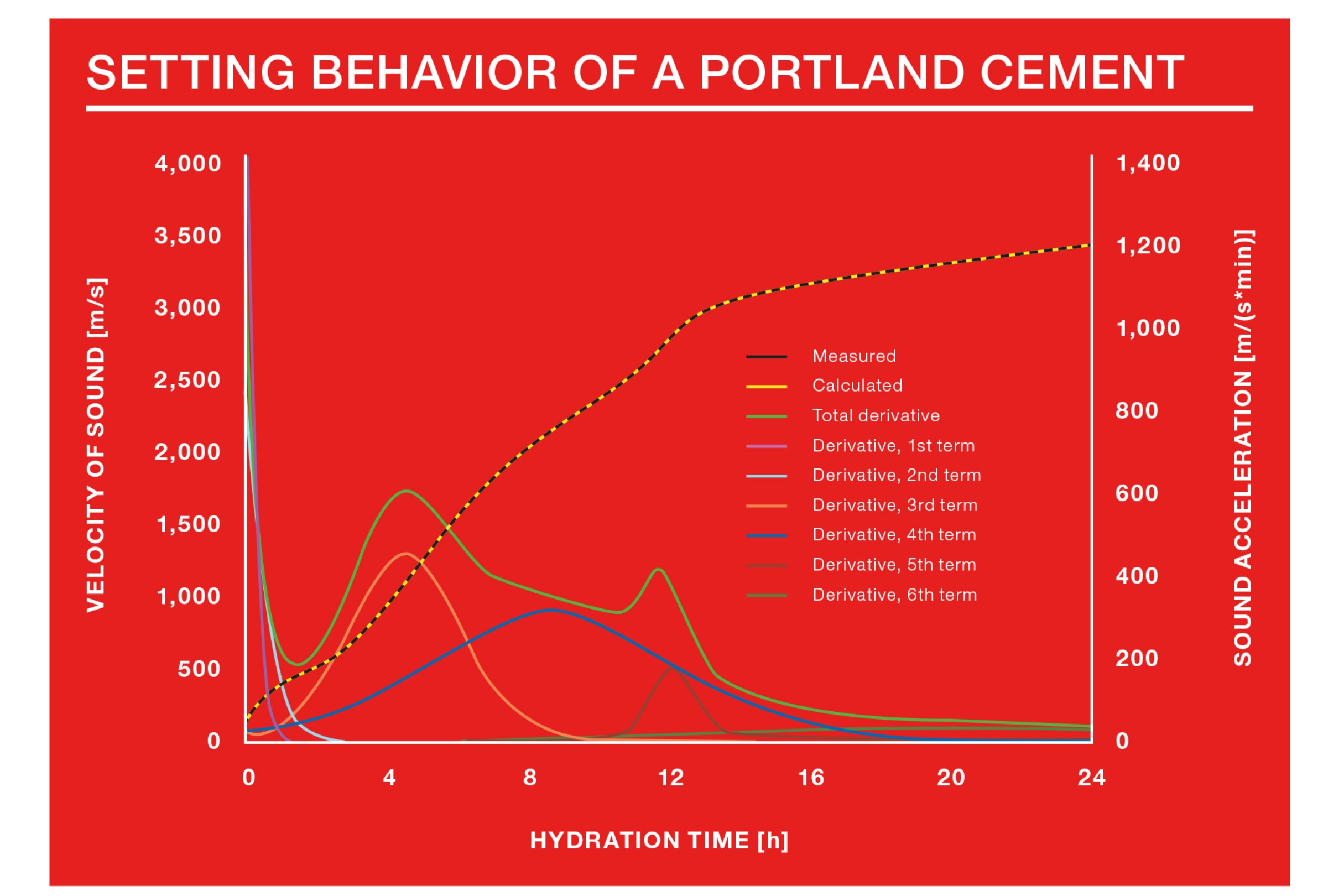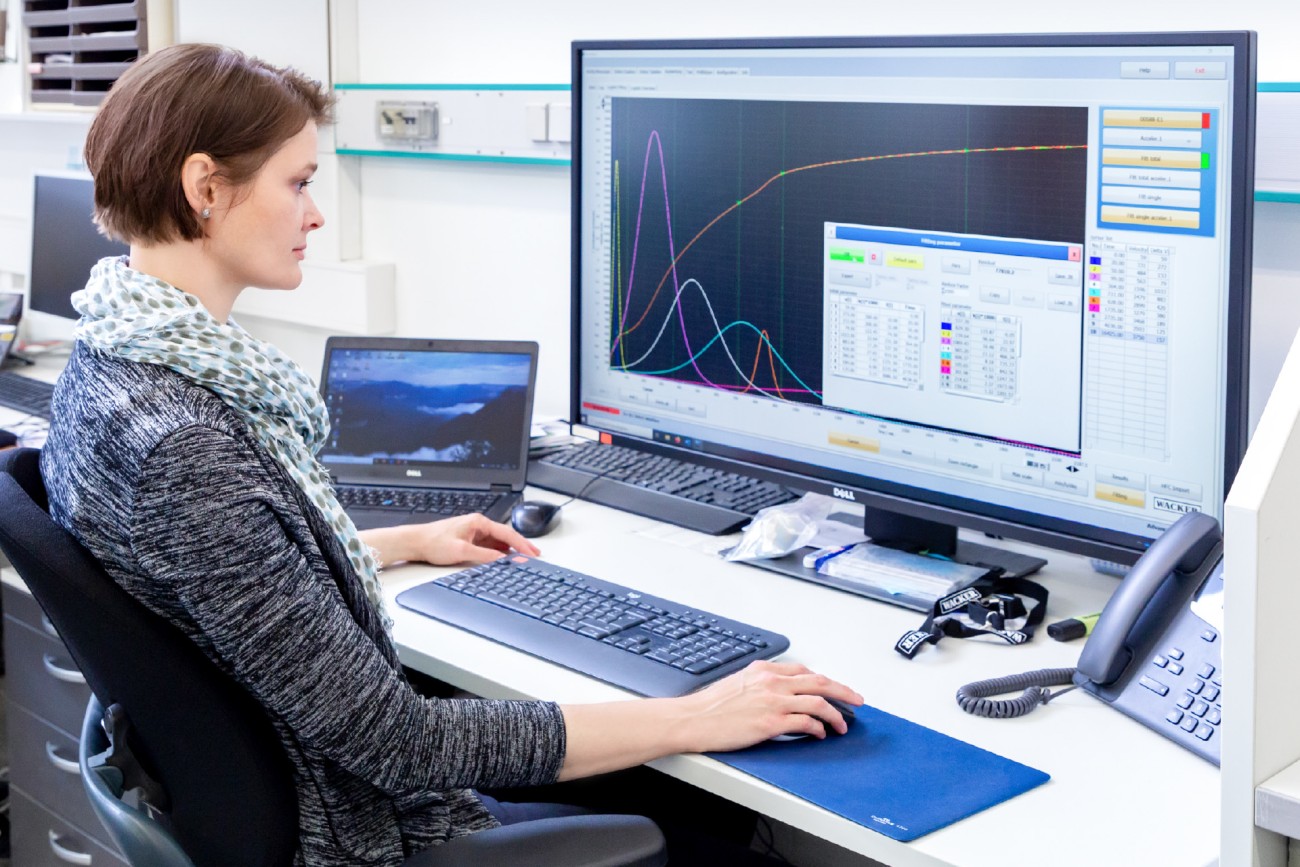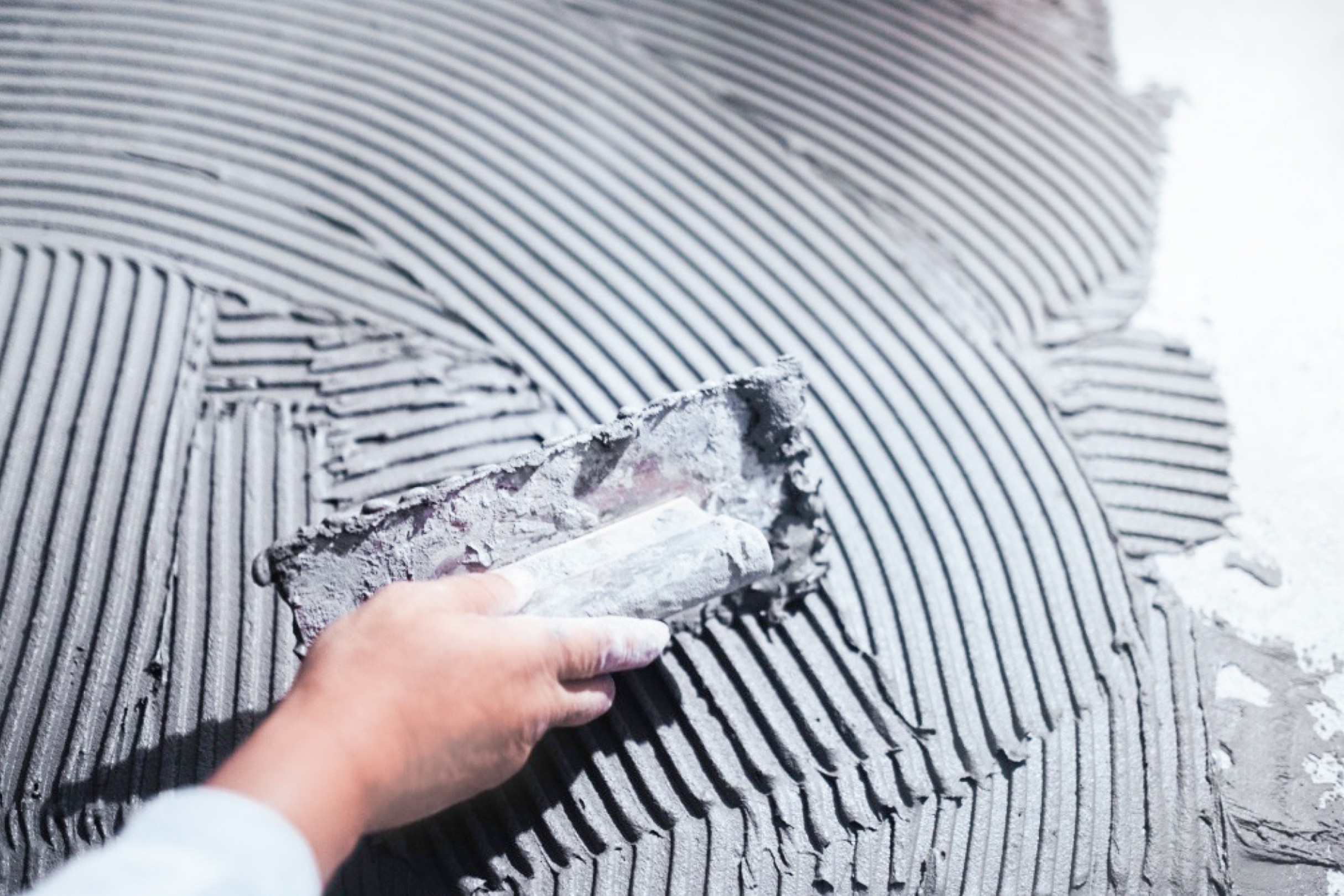
Focus on Sound Acceleration
Aug 30, 2021 Read time: approx. MinutesMinute
Quality Control by Ultrasound
Manufacturers of dry mortars are interested in how their products behave during setting. Together with UltraTest, WACKER has developed a new software module that reads detailed information from the propagation of ultrasound waves in the mortar as it sets. Manufacturers can use this method to better optimize their formulations.
As late as the mid-20th century, manufacturers were still mixing their mortars on site themselves – from cement, sand and water. The quality depended on the builders’ experience. Today, virtually only dry-mix mortars are used – ready-mixed compositions to which only gauging water needs to be added.
The advent of dry-mix mortar meant that construction-material manufacturers could produce a defined quality. In addition, they matched their formulations to the intended application by selecting the optimum cement, or other mineral binders, for the purpose, and using additives. A plaster mortar therefore has a different composition from a masonry mortar, which in turn is different from a tile adhesive or a self-leveling floor screed.
Additives are used to modify the properties of the mortar. They influence, for example, how easy it is to apply the mortar, how long it can be processed, how much it shrinks, or what strength it can reach. The dry-mix mortar manufacturer checks these properties during product development. It is particularly important for the developer to know what effect the additives will have on the individual setting stages.
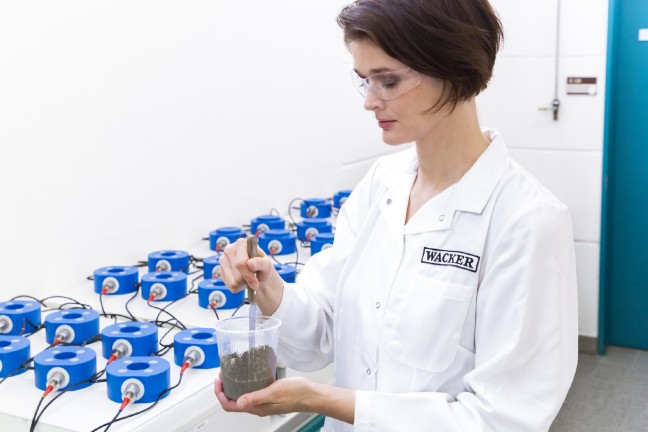
A self-leveling compound is stirred externally and then filled into test pots.
Ultratest GmbH: Bremen-Based Ultrasound Specialist
A new software module, the Logistic Fitting Module, allows developers to easily acquire such information from ultrasound measurements. The module was developed jointly by WACKER and UltraTest GmbH, a company based in Bremen, northern Germany. UltraTest is a well-known manufacturer of ultrasound measurement systems. This northern German company’s eight-channel ultrasound measurement system features the Logistic Fitting Module as a complement to its basic software.
Modern dry-mix mortars still usually contain cement as binder or as a component of a binder system. Cement is a fine-grained structure of several dehydrated mineral solids, which all react chemically with the gauging water to form crystalline hydrates – the experts call this a hydration reaction. During the initial setting and hardening, these crystals interlock with one another and develop into a solid network. This results in a porous solid body, which can no longer be plastically deformed.
Heat Flow Module
A different perspective on the setting of cement can be gained by measuring the heat liberated during the hydration reaction. Many dry-mortar manufacturers combine such heat-flow calorimetry investigations with the ultrasonic method. Users of the UltraTest ultrasonic measurement system now have access to a software add-on, the “Heat Flow Module,” which operates mathematically like the Logistic Fitting Module. It permits the results of heat-flow calorimetry studies to be read into the basic software of the ultrasound measurement system and evaluated.
Four Setting Stages
The hydration reactions of the individual cement components are staggered; they begin at different times and run at different rates. If a Portland cement, for example, is used as a binder, there are four stages during setting. The processes taking place in the individual stages can be investigated in detail with X-ray diffraction and ESEM, a scanning electron microscopic method. However, both these processes are time-consuming and expensive – construction-material manufacturers therefore try to avoid using them more than is absolutely necessary.
A much simpler, faster and more economical method is to measure the ultrasound velocity in the mortar as it is setting. It has been known since the 1950s that, the larger the dynamic modulus of elasticity of a pasty or solid mass, the faster ultrasound propagates in the material. For a setting mortar, that means that the velocity of sound increases the further the hardening has progressed. Immediately after the water has been stirred in, the ultrasound wave propagates at only 100 meters per second; in the set mortar, on the other hand, the ultrasound velocity is between 2,000 and 4,000 meters per second.
Hence, the progress of setting can be tracked by measuring the ultrasound velocity continuously. For evaluation, the measured velocity of sound is plotted against time in a graph. Just such a curve is provided by the UltraTest measurement system.
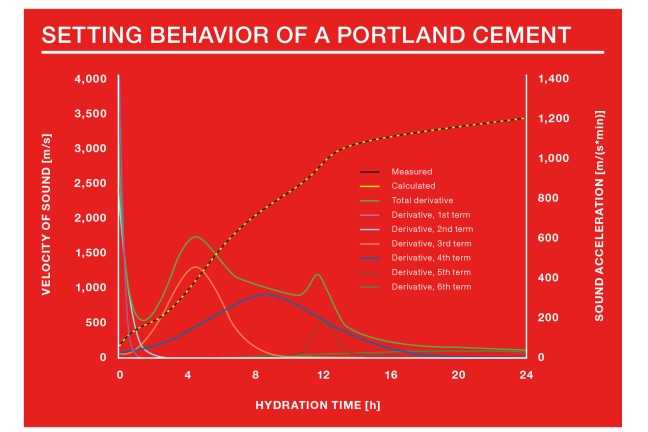
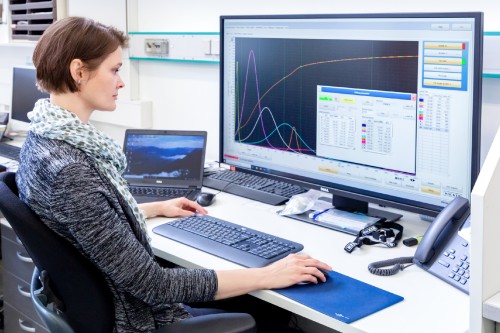
Christiane Treml evaluates the measurement curves by logistic fitting. The large monitor makes it easier to judge the quality of the fitting visually.
Focus on Sound Acceleration
“This sound velocity curve also includes information about the time profile of the hydration reactions; we use a mathematical method to bring it to light,” says Dr. Ingo Müller. The mineralogist, together with his colleague Christiane Treml, heads the software development project at WACKER POLYMERS. “We can clearly recognize the beginning and end of each individual hydration process by observing the changes in sound velocity with respect to time. So, it is particularly enlightening to investigate sound acceleration in detail.”
For the new software module, the team discovered a way to describe the sound velocity curve mathematically by means of a functional equation, from which the sound acceleration can be calculated. “We put together the functional equation for the entire setting process from individual mathematical terms and fit the equation to the measurement curve,” explains the WACKER expert. “This ‘fitting,’ as mathematicians call it, takes place with high accuracy.” The individual terms describe logistic growth, i.e. growth that starts exponentially then flattens out and finally almost comes to a halt. This is also the pattern that is followed by the velocity of sound, which reflects the progress of each individual hydration process.
The software module performs the fitting and calculates the sound acceleration for the entire setting process and for the individual terms. The accelerations calculated for the terms coincide on the time axis with the individual hydration processes. Their graphs are peaks in the form of Gaussian bell curves.
Precise Information
These peaks give the user precise information about when the individual processes take place and how long they last. “However, the ultrasound measurement does not give any indication about what is taking place physically or chemically in the processes,” stresses Müller. Only a time-resolved X-ray diffraction analysis of the setting cement allows the peaks to be assigned to the chemical reactions – this is most suitably performed using intense X-radiation from a synchrotron.
By investigating their formulations with ultrasound and evaluating the measurements with the Logistic Fitting Module, dry-mortar developers can check what effect an additive has on the individual hydration processes. They can also identify individual side effects of the additive, research them according to cause and take countermeasures.
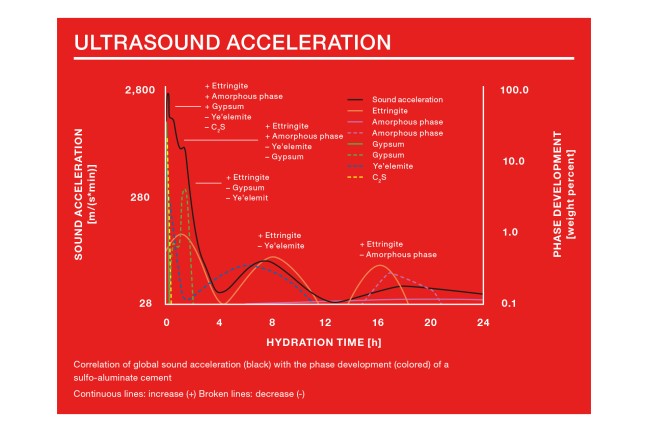
Dr. Müller advises product developers to start investigating the basic formulation right from the stage of pure binder and sand. X-ray diffraction is used here to clarify which peak in the ultrasound method models represents which hydration reaction. Once this assignment has been made, developers can blend in additives and consider how the peak positions in the ultrasound acceleration curve change. To be on the safe side, developers should check the result again with X-ray diffraction after completing the formulation work.
Developers have the advantage of a clear time and cost saving. It is no longer necessary to perform X-ray diffraction after each individual formulation step. To optimize a formulation, it is now sufficient to perform one, or at most two, of these complicated analyses – significantly fewer than were necessary until now.
WACKER offers users of the software module the service of performing the required time-resolved X-ray diffraction investigations. The studies are performed on the synchrotron at the Paul Scherrer Institute in Villigen, Switzerland.
“We put together the functional equation for the entire setting process from individual mathematical terms and fit the equation to the measurement curve.”
Dr. Ingo Müller, R&D Manager, WACKER POLYMERS
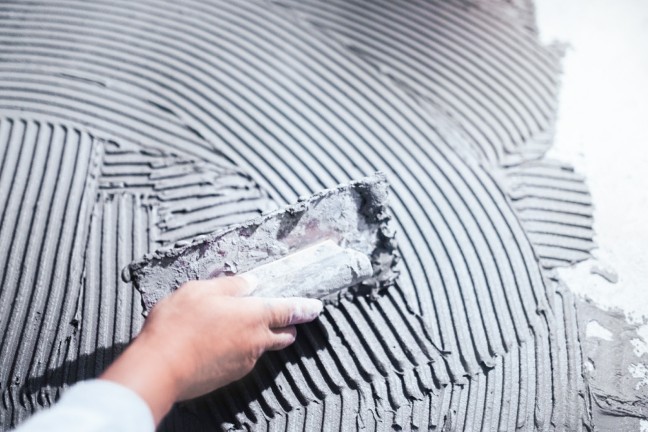
Applying tile adhesive: additives determine the properties of the material, for example how long it can be processed.
Shifted Peaks
The ultrasonic method can be used for quality control entirely without X-ray diffraction. In this case, dry-mix-mortar manufacturers only have to examine whether the mortar to be checked behaves just like a mortar from a faultless product batch. If one or more peaks have shifted, this indicates a quality problem.
Several construction-material manufacturers are already using the Logistic Fitting Module in practice. The Knauf Group, for example, was ready to test the software module immediately. Knauf is one of the biggest and best-known construction-material companies in the world.
Nina Krawtschenko, a qualified engineer working in R&D at Knauf, is currently checking the software module on existing mortar formulations, so that she can verify the information supplied by the software against other investigative methods. She notes that, “Our experience so far has been very positive. A particularly attractive feature for us is that we can better understand the effect of an additive. We are already highly motivated to use the software module in the future, including for our new developments.”




